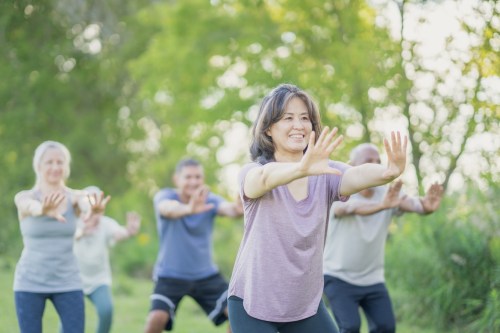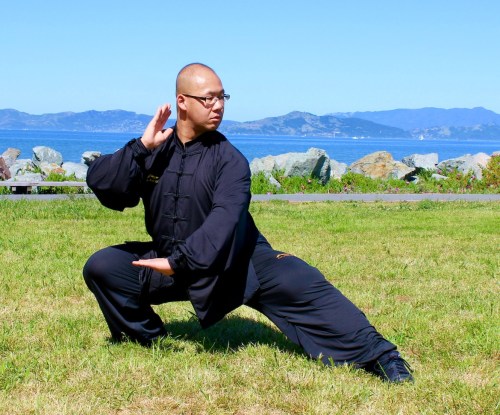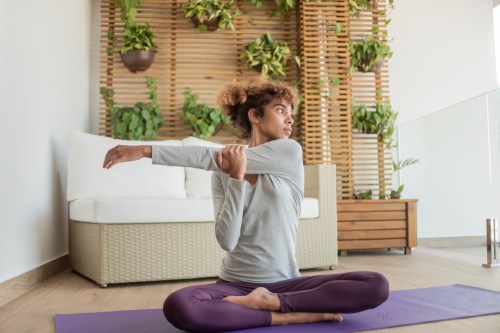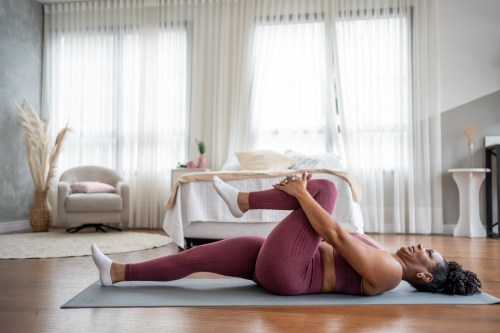Want To Age Well? Tai Chi Is the Activity Your Exercise Routine Might Be Missing
Tai chi teachers explain everything you need to know about tai chi for beginners, including how to add it to your fitness routine.

About 15 minutes into my online tai chi class, a notification popped up on my laptop about an email I’d been waiting for all morning. I dropped the exercise we were doing and ran over to check what it said. As soon as I did, though, I regretted it: I’d broken the meditative, stress-relieving spell I’d been in. Even my fingers had been tingling!
Experts in This Article
a tai chi teacher with the Tai Chi Foundation
a tai chi master and doctor of acupuncture and Chinese medicine
Luckily, once I jumped back into the movement, within a few breaths, I felt my heart rate calm and my shoulders relax down my back again. I ignored notifications for the rest of class to make sure I could soak up all the benefits of tai chi while I had the opportunity.
Although tai chi may be an ancient practice, modern exercise science shows it can lead to a longer1, healthier2 life in a number of ways. (Check out more exercises for longevity!)
“It’s not just a physical exercise,” says Mike Ng, DACM, CES, a tai chi master who is also a doctor of acupuncture and Chinese medicine. “It might start as that, but it’s really a full mind-body experience.”
What is tai chi?
There are several myths and legends surrounding tai chi’s origin story. But historians agree that tai chi started as a martial art in ancient China.
“It combines martial arts techniques with traditional Chinese philosophy, meditative breathing techniques, [and] theories drawn from traditional Chinese medicine,” Dr. Ng says.
Tai chi evolved with the philosophies of Daoism and Confucianism, eventually becoming a mind-body practice, according to the Smithsonian. Today, it’s most often used as a gentle form of exercise.
In contrast to your typical gym workout, however, tai chi focuses on relaxing the muscles rather than tensing them—it’s a restorative practice. With soft, circular movements, practitioners move slowly and deliberately to promote the circulation of energy (called “qi”) throughout your body. Dr. Ng says the practice is designed to help us balance opposing energies in order to encourage good health, which is a fundamental tenet of Chinese medicine.
“Tai chi allows us to experience the principles of yin and yang in our own bodies, and then start to apply them to all parts of life,” he says.
The different types of tai chi
As tai chi spread over the centuries, several different styles developed. Today, most modern practices stem from one of five primary traditions. Here’s how Dr. Ng distinguishes each one:
- Chen: The most original version of tai chi, Chen most closely resembles martial arts and includes bursts of power like stomping, jumping, or kicking.
- Yang: With smooth, graceful movements practiced at an even tempo, Yang is the most popular type of tai chi practiced around the world.
- Wu: This originates from Yang style, but is characterized by forward-leaning postures.
- Sun: This style is sometimes called “tai chi for arthritis” because it’s easy on the joints, with forward-and-back shuffling footwork that doesn’t demand too much leg strength.
- Wu/Hao: Focused on internal development with small, subtle movements, this is the least common of these five main styles.
“The more you practice tai chi, the more relaxed you get, both releasing physical tension—any kind of aches and pains—but also mental tension like stress and anxiety.” —Mike Ng, DACM, CES
6 benefits of tai chi that’ll convince you to give it a try
1. It’s very relaxing
As a form of moving meditation, tai chi’s repetitive motions can bring us into a calm, deeply internal state like that “spell” I felt I was under.
“We live in very stressful times,” says Margaret Olmsted, who has been teaching with the Tai Chi Foundation since 1976. “Anything that helps you center and relax and breathe is good. And tai chi is very good at all of those.”
The relaxation is both physical and mental, Dr. Ng points out: “The more you practice tai chi, the more relaxed you get, both releasing physical tension—any kind of aches and pains—but also mental tension like stress and anxiety.”
2. It’ll improve your balance
We begin to lose our ability to balance after age 503, Olmsted points out. Tai chi can be a way to improve our balance so we don’t lose it.
“It’s really good for fall prevention,” Dr. Ng says. Science backs this up: One 2023 study published in Frontiers in Public Health4 found that tai chi (particularly yang style) can improve balance in older adults. Another 2024 study in the Journal of Neurology, Neurosurgery & Psychiatry5 found practicing tai chi can reduce motor symptoms in patients with Parkinson’s disease, leading to fewer falls.
3. It may help reduce pain for certain conditions
The slow, gentle movements and focused breathing of tai chi could help ease some of your aching. In particular, if you have low-back pain6, fibromyalgia, or osteoarthritis in your knees7, science shows that tai chi can decrease some of the pain.
4. It’s good for your lungs
Focusing on integrating your breath with movement through tai chi can be good for your lungs as well. A 2021 review by The National Center for Complementary and Integrative Health8 found tai chi was better than breathing exercises alone or walking at helping improve lung function in people with chronic obstructive pulmonary disease (COPD).
5. It’ll give you a cognitive boost
Tai chi can give your brain a healthy workout, too. One 2019 study published in Clinical Interventions in Aging9 found tai chi could improve short-term cognitive function at the onset of dementia in older adults.
6. It’ll help you sleep easier
With its relaxing, stress-relieving effects, it’s not surprising that tai chi has been shown to help with sleep. Specifically, a 2024 study published in Frontiers in Neurology10 found that tai chi could improve sleep quality, extend sleep duration, and reduce daytime drowsiness.
The best tai chi moves to do
Every tai chi practitioner will have their own favorite movements. Below, Olmsted and Dr. Ng share some of theirs go-to tai chi exercises for beginners at home.
1. Ward off left and ward off right

- 1.Stand with your feet hip-width apart, arms down at your sides.
- 2.Take a step forward with your left foot and simultaneously lift your right heel off the ground, twisting your torso slightly to the left.
- 3.Bring your left hand up to chest height. This is ward off left.
- 4.Step your right foot forward and simultaneously lift your left heel off the ground, twisting your torso slightly to the right.
- 5.Bring your right hand up to chest height. This is ward off right.
2. Brush the knee

- 1.Begin this move in a T-stance where your right foot is planted and your left foot is out to the side, heel on the ground and toes facing toward the sky.
- 2.Lift one your right hand up, palm pacing front.
- 3.Your left hand is in front of the body, palm facing downward.
- 4.Twist your torso slightly to the left and push your raised hand forward, while putting the opposite hand down.
- 5.Bend your right knee as far as you can and extend your left leg out to the side.
- 6.To finish, circle your arms back to starting position.
- 7.Exhale on the push with the top hand and inhale on the circle back.
3. Parting the wild horse’s mane

- 1.Hold an imaginary ball with relaxed arms. Step forward, but don’t shift your weight forward.
- 2.Shift your weight to the middle.
- 3.Turn forward and shift your weight forward. Keep your back heel down.
- 4.Move your arms up and down in opposite directions.
- 5.Shift your weight backward. Keep your body vertical and turn from your hips.
- 6.Shift your weight forward. Bring your back leg forward. Form the ball with your arms.
“It is a lifelong journey. So just enjoy the process and have fun with it.” —Mike Ng, DACM, CES
Tips to get started
1. Find the right teacher
Because the tai chi experience is so much about the energy you feel, Dr. Ng suggests making sure to find a teacher you vibe with. Note: Tai chi instructors do not need to be licensed, though there are certification programs with varying criteria so it can be helpful to look into a teacher’s experience and education.
Fortunately, even if you don’t live in an area where you can practice tai chi in person, there are several beginner-friendly online classes you can join, including some for free from the Tai Chi Foundation, Olmsted points out.
2. Practice regularly
Once you begin, the best way to pick up tai chi is to do it regularly, even if you only have five minutes a day, Dr. Ng says. “If you’re practicing one movement or two movements every day, that consistency really goes a long way.”
3. Find that balance of energy
One of the most helpful things to focus on in the beginning is finding a balance between relaxation and support, being neither too tense nor too loose in your body. “There is freeness within the form, but also form within the freeness,” Dr. Ng says.
4. Start with quality rather than quantity
As a newbie, it can feel like there’s a lot to learn. But Dr. Ng suggests keeping your focus narrow.
“Don’t get too consumed with learning what the next guy’s learning,” he says. “It’s nice to be inspired by some of the more advanced movements. But you’ll find the true benefit is not when you’re chasing new movements, but when you cultivate and work at what you’re currently learning.”
FAQ
1. Who can do tai chi? (And who can’t?)
The quiet, soft movements of tai chi can be done by nearly anyone. This can make the practice a draw for seniors as well as people recovering from injury—it’s a low-risk, low-impact way to keep moving. Although it’s traditionally done standing, Olmsted says she sometimes has students who take class in a seated position, focusing only on the upper body.
That doesn’t mean it’s only for those who need a safer workout. Dr. Ng says he teaches people of all ages and abilities: “I do have students [who are] retired. But I also have college students, graduate students, working professionals who are finding that it’s really beneficial for stress management, for focus, mood, sleep, all of these things.”
2. Are there any disadvantages to tai chi?
Tai chi may look easy, but the focus and patience required can make it surprisingly difficult. “To take it to the higher levels, to really be able to do what some of these remarkable people can do takes a lot of time and effort and focus and investment,” Olmsted says.
3. How hard is it to learn tai chi?
Although Olmsted admits it might feel easier to pick up the movements when you’re younger, anyone can do tai chi as long as you’re dedicated. “It is a lifelong journey,” Dr. Ng adds. “So just enjoy the process and have fun with it.”
Moriyama N, Kuga T, Oshima T, Sato K, Kurita M, Yasumura S. Association between Tai Chi Yuttari Exercise and Longevity and Prevention of Long-Term Care Need: Survival Analysis in Kitakata City, Japan. Int J Environ Res Public Health. 2023 Feb 16;20(4):3472. doi: 10.3390/ijerph20043472. PMID: 36834168; PMCID: PMC9961723.
↩︎Huston P, McFarlane B. Health benefits of tai chi: What is the evidence? Can Fam Physician. 2016 Nov;62(11):881-890. PMID: 28661865; PMCID: PMC9844554.
↩︎Katherine S. Hall, Harvey J. Cohen, Carl F. Pieper, Gerda G. Fillenbaum, William E. Kraus, Kim M. Huffman, Melissa A. Cornish, Andrew Shiloh, Christy Flynn, Richard Sloane, L. Kristin Newby, Miriam C. Morey, Physical Performance Across the Adult Life Span: Correlates With Age and Physical Activity, The Journals of Gerontology: Series A, Volume 72, Issue 4, 1 April 2017, Pages 572–578, https://doi.org/10.1093/gerona/glw120
↩︎Chen W, Li M, Li H, Lin Y, Feng Z. Tai Chi for fall prevention and balance improvement in older adults: a systematic review and meta-analysis of randomized controlled trials. Front Public Health. 2023 Sep 1;11:1236050. doi: 10.3389/fpubh.2023.1236050. PMID: 37736087; PMCID: PMC10509476.
↩︎Li G, Huang P, Cui S, He Y, Tan Y, Chen S. Effect of long-term Tai Chi training on Parkinson’s disease: a 3.5-year follow-up cohort study. J Neurol Neurosurg Psychiatry. 2024 Feb 14;95(3):222-228. doi: 10.1136/jnnp-2022-330967. PMID: 37875337.
↩︎Qin J, Zhang Y, Wu L, He Z, Huang J, Tao J, Chen L. Effect of Tai Chi alone or as additional therapy on low back pain: Systematic review and meta-analysis of randomized controlled trials. Medicine (Baltimore). 2019 Sep;98(37):e17099. doi: 10.1097/MD.0000000000017099. PMID: 31517838; PMCID: PMC6750325.
↩︎Ye Y, Liu A. The Effectiveness of Tai Chi for Knee Osteoarthritis: An Overview of Systematic Reviews. Int J Gen Med. 2023 Oct 4;16:4499-4514. doi: 10.2147/IJGM.S434800. PMID: 37814642; PMCID: PMC10560483.
↩︎Liu X, Fu C, Hu W, Hao S, Xie L, Wu X, Wang J, Liu Z, Lin Q, Li S. The effect of Tai Chi on the pulmonary rehabilitation of chronic obstructive pulmonary disease: a systematic review and meta-analysis. Ann Palliat Med. 2021 Apr;10(4):3763-3782. doi: 10.21037/apm-20-940. Epub 2021 Apr 15. PMID: 33894710.
↩︎Lim KH, Pysklywec A, Plante M, Demers L. The effectiveness of Tai Chi for short-term cognitive function improvement in the early stages of dementia in the elderly: a systematic literature review. Clin Interv Aging. 2019 May 8;14:827-839. doi: 10.2147/CIA.S202055. PMID: 31190769; PMCID: PMC6512568.
↩︎Wang C, Jiang T, Li H, Cao G, Zhang G. The effects of Tai Chi exercise on sleep quality among the elderly: a study based on polysomnographic monitoring. Front Neurol. 2024 Mar 8;15:1304463. doi: 10.3389/fneur.2024.1304463. PMID: 38523606; PMCID: PMC10957755.
↩︎
Sign Up for Our Daily Newsletter
Get all the latest in wellness, trends, food, fitness, beauty, and more delivered right to your inbox.
Got it, you've been added to our email list.










